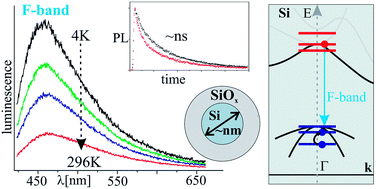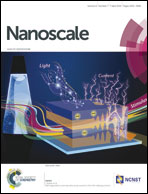A complex study of the fast blue luminescence of oxidized silicon nanocrystals: the role of the core†
Abstract
Silicon nanocrystals (SiNCs) smaller than 5 nm are a material with strong visible photoluminescence (PL). However, the physical origin of the PL, which, in the case of oxide-passivated SiNCs, is typically composed of a slow-decaying red–orange band (S-band) and of a fast-decaying blue–green band (F-band), is still not fully understood. Here we present a physical interpretation of the F-band origin based on the results of an experimental study, in which we combine temperature (4–296 K), temporally (picosecond resolution) and spectrally resolved luminescence spectroscopy of free-standing oxide-passivated SiNCs. Our complex study shows that the F-band red-shifts only by 35 meV with increasing temperature, which is almost 6 times less than the red-shift of the S-band in a similar temperature range. In addition, the F-band characteristic decay time obtained from a stretched-exponential fit decreases only slightly with increasing temperature. These data strongly suggest that the F-band arises from the core-related quasi-direct radiative recombination governed by slowly thermalizing photoholes.


 Please wait while we load your content...
Please wait while we load your content...